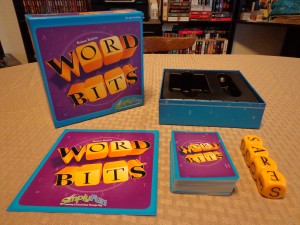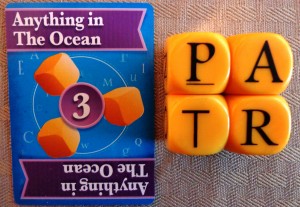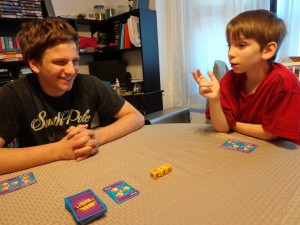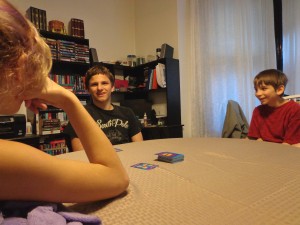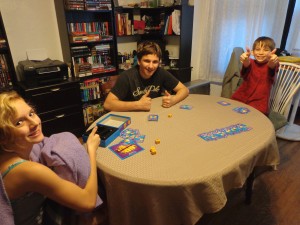I’ve played many word games over the past year: “Boggle”, “Scrabble Blast”, “WayWord”, “Upwords”, “Word on the Street”, “Jumbalaya”…you get the idea. You’d think that if you played one, you played them all, but any parent worth their two cents knows that this just isn’t the case. Needless to say, I was happy to receive yet another one to try out and review with the kids. Before we take a look at the game and reveal why games like this are beneficial, I’d like to thank Sue Jefferson from SimplyFun for sending me a free review copy.
Components
Dice – There are four dice with common letters on their faces.
Cards – Players will be trying to capture these category cards by spelling out words using the letters on the dice. Category cards list not only a category, but how many dice to roll for that round. More on that in a bit.
Setup & Gameplay
Setting up the game simply requires the deck to be shuffled and placed within easy reach of players. The dice are placed nearby as well.
Gameplay is also very simple. First, the top card is revealed and placed on the table for all to see. After that, a player rolls the number of dice listed on the card. Once the letters are revealed, players must race to find a word that not only fits the category, but includes the letters that are rolled. The first person to announce a word that fits all of these criteria captures the card and places it into their score pile.
Players rinse and repeat until the deck of cards runs out. Players can shorten the game by playing with only half a deck. The person with the most cards at the end of the game wins!
The above is simply an overview of the game, but gives you the general idea. For those of you interested in seeing more, SimplyFun has a video tutorial on their website, located here:
The Review
The components are easy on the eyes and the letters on the dice themselves were large enough for me to see them from where I was sitting. My regular readers know by now that my eyesight isn’t all that up to spec, so functional components are important in my household. The manual was also very easy to read and I didn’t have to consult it again once I was done.
Most of the games I review have a strategy element to it, though in this case, one isn’t needed. The educational value alone is more than enough to justify the price tag. My son Vinnie (11) is excellent at subjects like math, but has issues in the vocabulary department. Games like this help me to review vocabulary with him all the while having fun, the former of which I found is much more effective when the latter is present.
I also appreciate that the game is flexible enough to add your own rules to it. As an example, I make Vinnie read the categories aloud as they are drawn. There’s a lot of room there for teachers to do the same in the classroom…that is, award their student with extra points for saying it aloud, spelling it, and etc. You can alter the rules in other ways by increasing or decreasing the amount of dice a card says to roll, thereby increasing or decreasing the difficulty level. With the right parental coaching, this can make the game viable for children under the age of eight. You could also make players say two words, or even three, instead of one in order to claim a category card. Or, you could grab a piece of paper and a sand timer and write out as many words as you can. You could do away with the competition and just challenge each player to come up with a word. It’s easy to see the potential when it comes to inventing applicable variants to the base game.
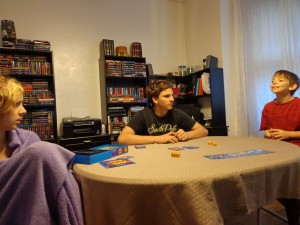
The game allows you to be flexible…though Vinnie discovered that some words just don’t work no matter how much you argue for them.
Anthony (16) and Vinnie (11) both came up with some unique answers, though Anthony had the obvious advantage. When I saw that Anthony was dominating in a few rounds, I directed the next category to Vinnie alone, giving him a chance to come up with a word without the pressure of competition. Carolyn (13) was watching television and decided to join us midway through our game…something she rarely does. She enjoyed her time with it and we all played another game afterwards, though I spent most of the time on our second playthrough moderating. The kids got a kick out of coming up with strange, warped words that didn’t make much sense. In other words, the game kept their imaginations going and allowed them to be as silly as they wanted.
In the end, “Word Bits” is an excellent way to review vocabulary with your kids. Its fast and furious nature will keep their minds alert and thinking, but the game is flexible enough to where you can alter the rules to easily fit their needs. I highly recommend this game to families and schools everywhere, more so to those who have kids that require a little push in their Language Arts classes.
Final Verdict: 9/10
—
You can learn more about “Word Bits” by visiting the following website:
—

